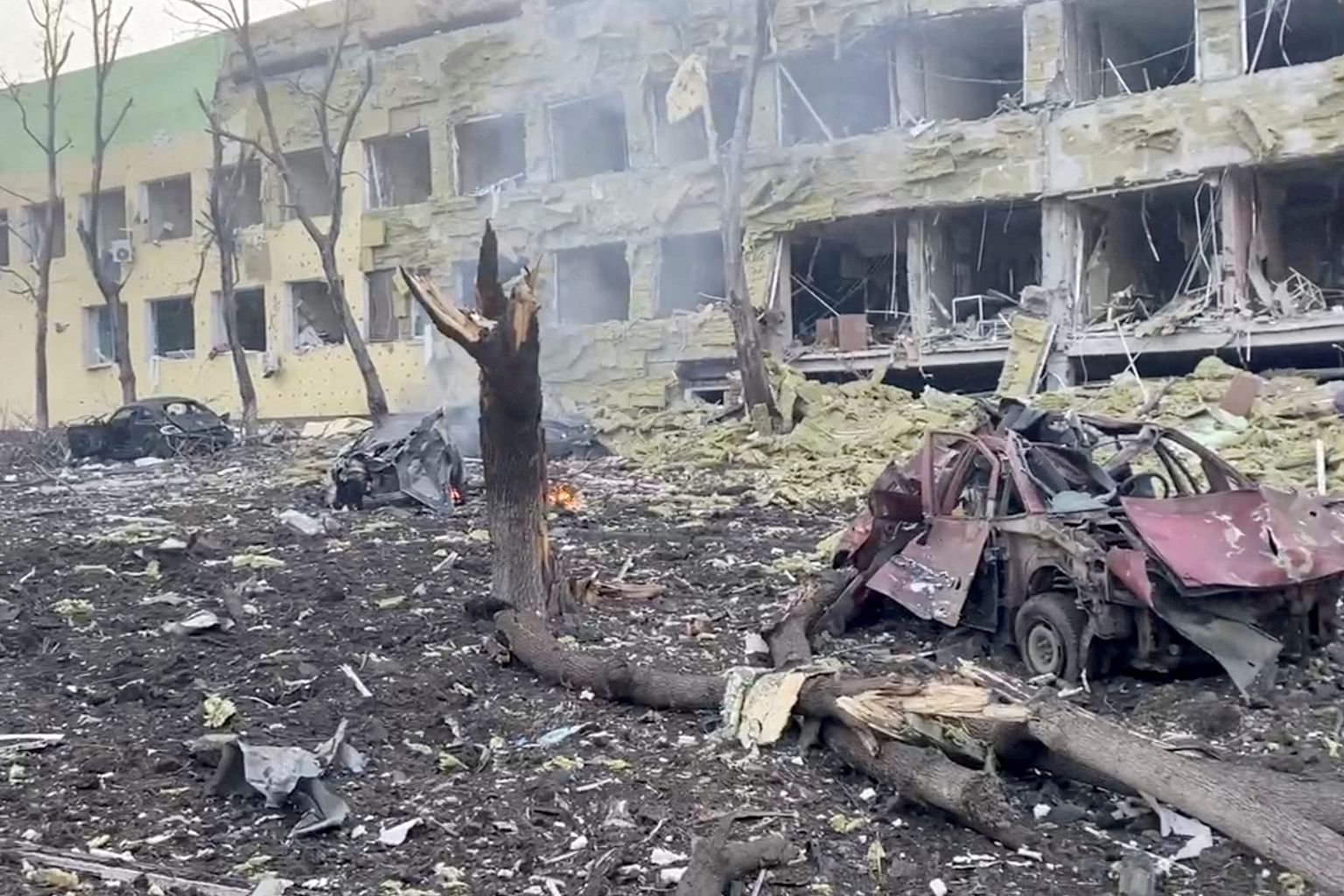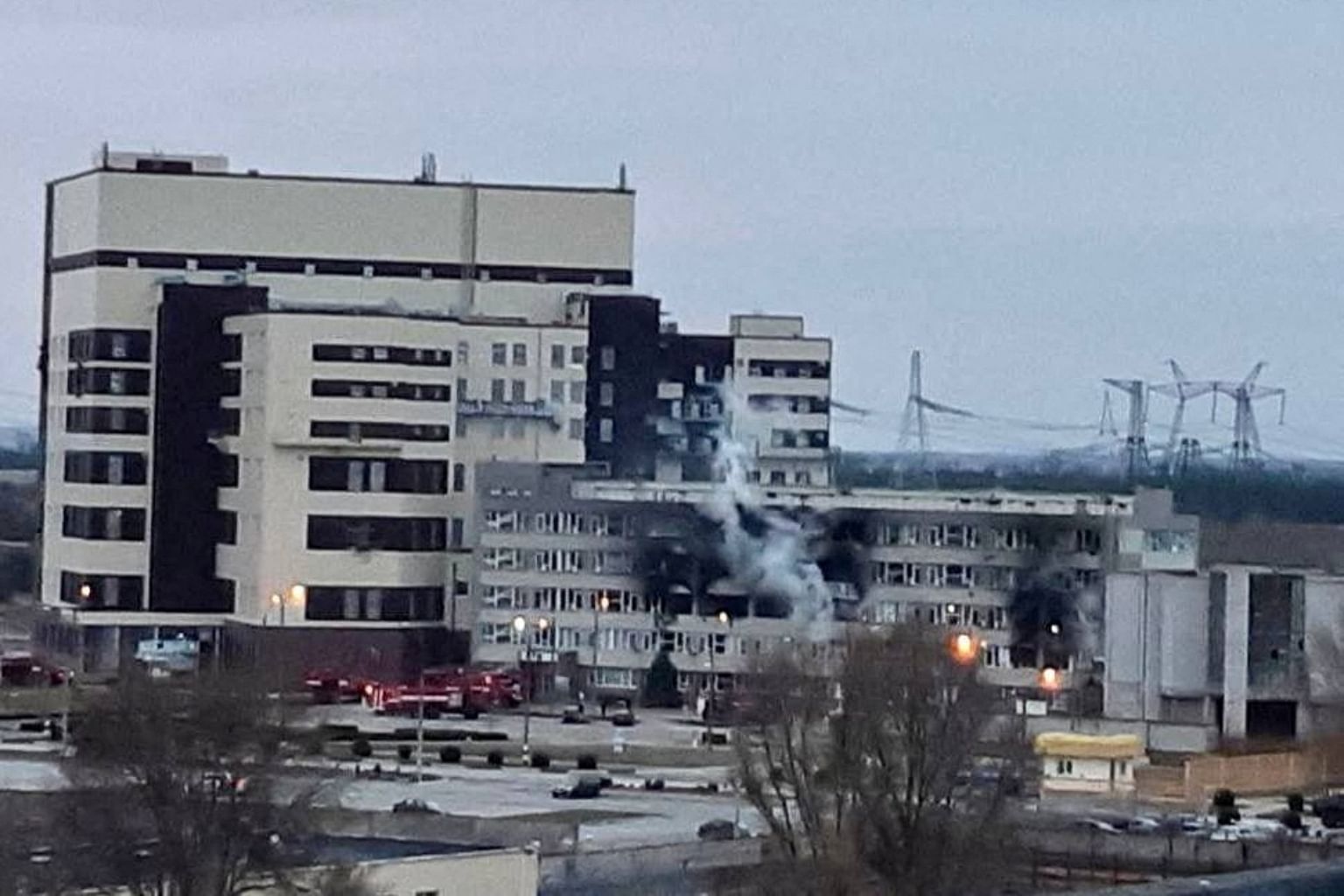NEW YORK (NYTIMES) - To many audiences, Russia's invasion of Ukraine has unfolded as a series of brutal attacks punctuated by strategic blunders. But on Russian television, those same events were spun as positive developments, an interpretation aided by a rapid jumble of opinion and falsehoods.
Much of Russian news media is tightly controlled by the Kremlin. Critical reporting about the war has been criminalised.
Russian television's convoluted and sometimes contradictory narratives about the war are not solely intended to convince viewers that their version of events is true, disinformation experts say. Just as often, the goal is to confuse viewers and sow distrust so audiences are not sure what to believe.
The New York Times reviewed more than 50 hours of television footage to show how the war was being presented to Russians through the country's news media.
April 14 : Prized Russian ship sunk by Ukrainian missiles
Russia faced a significant loss when its flagship missile cruiser, the Moskva, sank after being damaged in mid-April. Ukrainian officials said the ship was struck with two Neptune anti-ship missiles. The Times reported this week that the United States provided intelligence that helped Ukraine locate and strike the ship. Independent Russian news media based outside the country reported that about 40 men died and an additional 100 were injured.
On Russian state-controlled media, though, news programmes downplayed Ukraine's strategic attack with a narrative that has shifted over time.
At first, Russia's Defence Ministry said the ship was damaged after a fire on board had detonated ammunition. The ship was being towed back to shore and the crew was safely evacuated, the report said.

Russian media later reported that the ship had sunk while being towed during a storm. A segment also showed a lineup of healthy Russian sailors, describing them as the Moskva's crew, alive and well.
Russia acknowledged the overall death toll for the first time in March, making clear to Russian viewers that the war would involve domestic losses as well. But even those reports underestimated the Russian casualties, according to US experts. Although it is difficult to get exact casualty figures during a war, Western intelligence agencies estimate Russian military losses could be as high as 10,000 killed and 30,000 wounded.
April 2: Bodies line the streets of Bucha

As Russian forces retreated from the region surrounding Ukraine's capital, Kyiv, graphic images circulated showing the bodies of civilians lying in the streets. In Bucha, a suburb of Kyiv, some civilians were found with their hands bound or with gunshot wounds to the head. The images prompted renewed calls for war crime charges against Russia.
On Russian television, the discovery was cast instead as a hoax, with television presenters analysing images and video for signs of fakery.
In one clip, Russian journalists noted that clothing on some dead civilians was too clean to have been in the streets for days, implying the civilians could not have been killed during Russia's occupation. A statement from the Defence Ministry, aired on the nightly newscast "Vremya", said that the bodies lacked signs of decay and that blood in their wounds had not coagulated.
"All that is irrefutable evidence that the photos and videos from Bucha are yet another staging by the Kyiv regime for the benefit of Western mass media," the ministry's statement said.
Unblurred photographs run by Western media outlets, however, showed the bodies had clear signs of decay.
Another news report indicated that footage from Bucha showed some of the bodies moving, which was cited as proof that the bodies were staged. One clip showed a body in a rear-view mirror that appeared to move after the car drove by. But several photographs taken on the ground by Western photographers showed bodies in the area had clear signs of decomposition. The impression of movement appeared to be caused by distortion in the mirror, which was also seen affecting the buildings surrounding the body.
The claim that the bodies in the streets were part of a staging collided later with an entirely different narrative pushed on Russian television: that the civilians were indeed killed but that it was Ukrainian troops who had killed them.
March 9: Maternity hospital bombed

Russia drew international condemnation after a maternity hospital was bombed in the southern port city of Mariupol. Images of injured pregnant women, carried across charred hospital grounds or ushered down battered staircases, made clear to Western audiences the civilian cost of war.
In Russia, though, the attack was dismissed as a hoax.
In a flurry of claims over several days, Russian television dissected footage and raised numerous doubts about the Western account, often using the same imagery seen in the West to advance different accounts of what happened.
Images of two women in particular were widely circulated in Western media. One, an influencer named Marianna Vyshemirskaya, survived the attack and later gave birth to a girl. Another woman, who has not been identified, was photographed on a stretcher and was later reported by The Associated Press to have died. In one segment, Russian journalists claimed the two were the same woman. Vyshemirskaya later denied being the woman seen on the stretcher.
In another segment aired on Russian television, victims being carried away from the hospital were described as soldiers from Ukraine's far-right Azov Battalion, a unit of the Ukrainian national guard with ties to the country's neo-Nazi movement. But images captured by Western journalists showed the victims were women, with some wearing khaki-coloured clothing that vaguely resembled troop uniforms.
Vyshemirskaya later gave an interview to Denis Seleznev, a Ukrainian blogger who backs the separatist movement in Ukraine's eastern Donbas region. The portions that aired on Russian television focused not on her injuries but on the Azov Battalion, with claims that the military group occupied the hospital before the strike took place.
There was no evidence reported by Western journalists on the scene that Azov was using the building as a base, and an April report by the Organisation for Security and Cooperation in Europe classified the attack on the hospital as a war crime.
In airing Vyshemirskaya's interview, alongside a video she posted to Instagram, Russian news media focused on her description of Azov soldiers, casting them as belligerent occupiers who demanded food.
"They said they haven't eaten for five days," she said. "They took our food away and said, 'You can cook more.' "
The Kremlin and Russian media have frequently focused on Ukraine's neo-Nazi movement as justification for the invasion. President Vladimir Putin of Russia said that one of his central aims was the "denazification of Ukraine". Although the Azov Battalion was founded in 2014 out of Ukraine's ultra-nationalist and neo-Nazi groups, experts say the group has quelled much of its extremist side under pressure from authorities.
The neo-Nazi movement is not a significant force in Ukraine, according to experts who track the far right, who point to Ukraine's election of President Volodymyr Zelensky, who is Jewish, as evidence.
March 4: Zaporizhzhia nuclear plant attacked

Russian forces advanced on Europe's largest nuclear power plant in early March. A skirmish with Ukrainian forces ended with a fire at the compound, which Zelensky warned could result in "the end of Europe". The fire was later extinguished, but Ukrainian officials accused Russia of "nuclear terrorism".
But Russian audiences were told another story: that Ukrainian soldiers had attacked the facility, setting fire to the building before fleeing. Russian forces were described as defending the facility from "Ukrainian saboteurs", according to a government statement repeated in state media.
In footage released weeks later, the power plant was shown functioning normally, with drone shots showing workers arriving at a spotless facility and passing through security checkpoints in an orderly fashion.
"While the special military operation is underway, the nuclear power plant hasn't stopped working for a second," said Aleksey Ivanov, a reporter for "Vremya", the Channel 1 evening news broadcast. "And now it has even grown in strength."
Ivanov also said that Russian guards "do not interfere with the work of the plant". A soldier interviewed at the facility said that "employees of this plant show a certain amount of respect" and that workers "maintain order and discipline in their work".
The idea that Ukraine is faring better under Russian control continues to be a frequent claim on state television, bolstering the dubious argument advanced by Putin that Russian troops were sent in to protect Ukrainian citizens.

